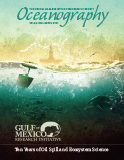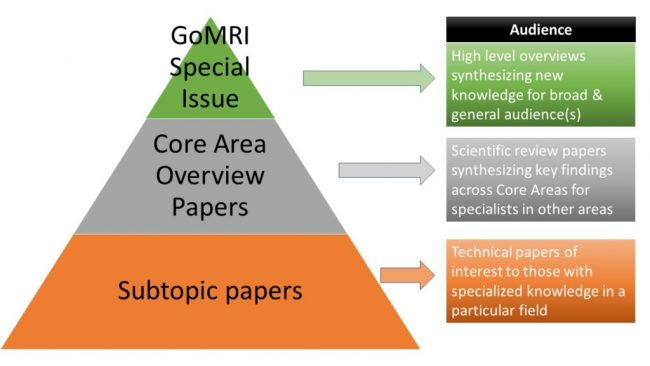Products
GoMRI Special Issue in Oceanography Magazine
As a culmination of all GoMRI projects, the special issue in Oceanography has now been published. The special issue represents the main scientific accomplishments by summarizing the culmination of a decade of research supported by GoMRI. This collection of articles describes key advances, surprises, and novel discoveries for the Gulf of Mexico and other regions where GoMRI research has application. Several articles focus on lessons learned, outstanding research needs, and gaps to inform future activities and efforts. The issue is available online HERE. To download a PDF copy of the entire issue, visit HERE.
Synthesis Products
In total, nearly 50 unique products resulted from the GoMRI Synthesis effort. As illustrated, these products have a variety of target audiences.
Core Area 1 – Plume & Circulation Observations & Modeling
GoMRI’s Synthesis Core Area 1, Plume & Circulation Observations & Modeling, focused on several physical oceanography areas of interest. Teams of GoMRI researchers collaborated to highlight research and modeling advances, and their relevance for oil transport and fate, in: 1) transport processes in the Gulf of Mexico along the river-wetland-estuary-coastal-open ocean continuum, 2) near-field, mid-field, and far-field dynamics of the plume, and 3) small-scale/near-surface/sub-mesoscale observations.
- A Review on Multiphase Underwater Jets and Plumes: Droplets, Hydrodynamics, and Chemistry
- Advances in Observing and Understanding Small-Scale Open Ocean Circulation During the Gulf of Mexico Research Initiative Era
- Transport, Fate and Impacts of the Deep Plume of Petroleum Hydrocarbons Formed During the Macondo Blowout
- Additional GoMRI Core 1 Synthesis Publications
Core Area 2 – Fate of Oil & Weathering: Biological & Physical-Chemical Degradation
GoMRI’s Synthesis Core Area 2, Fate of Oil & Weathering: Biological & Physical-Chemical Degradation, reviewed research advances related to several areas: methods of oil spill chemical analysis, use of genomics and proteomics, use of molecular biology tools, general exposure studies and techniques, photochemical reactions at sea and on shorelines, microbial degradation, Marine Oil Snow Sedimentation and Flocculent Accumulation (MOSSFA), and alternative dispersant research and technologies.
- Advances in Chemical Analysis of Oil Spills Since the Deepwater Horizon Disaster
- The Complexity of Spills: The Fate of the Deepwater Horizon Oil
- The Science Behind Marine-oil Snow and MOSSFA: Past, Present, and Future
- Why Sunlight Matters for Marine Oil Spills
- Photochemical Weathering of Oil at Sea Publication
- Gulf of Mexico Research Initiative Synthesis Workshop I MOSSFA Workshop Report
- Marine Oil Snow Sedimentation and Flocculent Accumulation (MOSSFA) Workshop Report
- Integrating marine oil snow and MOSSFA into oil spill response and damage assessment
- GoMRI Contributions to Dispersant Science Workshop Report
- Additional GoMRI Core 2 Synthesis Publications
Core Area 3 – Ecological/Ecosystem Impacts
GoMRI Synthesis Core Area 3, Ecological/Ecosystem Impacts, summarized research and identified gaps related to ecosystem impacts and the vulnerability and resilience of species and ecosystems to large-scale contamination events. Cross-cutting ecological impacts were investigated for several ecotypes: open-ocean, deep benthic, continental shelf, and coastal in-shore.
- DEEPEND Deep Pelagic Ecosystem Dynamics Special issue
- A Synthesis of Deep Benthic Faunal Impacts and Resilience Following the Deepwater Horizon Oil Spill
- NMMF 10 Years After the Deepwater Horizon Oil Spill
- GoM Passive Acoustic Monitoring (PAM) white paper
- Additional GoMRI Core 3 Synthesis Publications
Core Area 4/5 – Human Health, Socioeconomic Impacts, and Ecosystem Services
GoMRI’s Synthesis Core Areas 4/5, Human Health, Socioeconomic Impacts, and Ecosystem Services, translated scientific findings to develop a conceptual framework for an Operational Community Health Observing System for the Gulf of Mexico states. The concept of allostatic load was applied to the practical measurement of exposure to oil spills, further operationalizing new assessment techniques.
- Disasters, the COVID-19 Pandemic, and a Human Health Observing System
- Framework for a Community Health Observing System for the Gulf of Mexico Region: Preparing for Future Disasters
- A Conceptual Framework for a Community Health Observing System for the Gulf of Mexico Region
- Building Community Resilience to Large Oil Spills: Findings and Recommendations from a Synthesis of Research on the Mental Health, Economic, and Community Distress Associated with the Deepwater Horizon Oil Spill
- Oil Spills and Human Health: Contributions of GoMRI
- Additional GoMRI Core 4/5 Synthesis Publications
Core Area 6 – Microbiology, Metagenomics & Bioinformatics
GoMRI’s Synthesis Core Area 6, Microbiology, Metagenomics & Bioinformatics, generated foundational ideas to advance marine microbiology and enhance understanding of microbial response to major disturbances in the ocean.
- Microbial Genomics of the Global Ocean System Report
- How Microbes Clean up Oil: Lessons From the Deepwater Horizon Oil Spill
- Microbial Genomics Can Measure Change in the World’s Oceans
- Deepwater Horizon and the Rise of the Omics
- Additional GoMRI Core 6 Synthesis Publications
Core Area 7 – Integrated/Linked Modeling System
GoMRI’s Synthesis Core Area 7, Integrated/Linked Modeling System, focused on operational oil spill modelling, including ocean, wave, and weather forecasting, and development of a systems dynamic model, which could be used for future decision-making.
- Ten Years of Modeling the Deepwater Horizon Oil Spill
- Operational Oil Spill Forecasting Workshop Report
- Progress in Operational Modeling in Support of Oil Spill Response
- 7B Webinar Series to Inform an Integrated / Linked Modeling System
- Additional GoMRI Core 7 Synthesis Publications
Core Area 8 – Knowledge Exchange with User Communities: Lessons Learned and Operational Advice
GoMRI’s Synthesis Core Area 8, Knowledge Exchange with User Communities: Lessons Learned and Operational Advice, served as an advisory group that assisted in identifying lessons learned, promoted the effective application of GoMRI research results, and improved operational advice. The advisory group was comprised of representatives from academia, industry, the response community, government agencies, the NGO community, and other critical stakeholder groups. The members of this advisory group were routinely informed, and provided input to, the activities and results of other Core Area.
Please check back often, as there are multiple synthesis products currently in development! For a complete, and growing list of GoMRI Synthesis publications and so much more, please visit the GoMRI Publication Database.
Legacy Products
- C-IMAGE Consortium Book: Deep Oil Spills: Facts, Fate, and Effects 2020
- C-IMAGE Consortium Book: Scenarios and Responses to Future Deep Oil Spills 2020
- Special Issue Featuring the Gulf of Mexico Research Initiative: Research Resulting from the 2010 Deepwater Horizon Oil Spill. Current: The Journal of Marine Education 33:1 (1-48) 2019
- S. Beresford, K. Fillingham, T. Miller-Way, Recommendations for Science Outreach Program Development: Perspectives from Gulf of Mexico Research Initiative Consortia. Limnology and Oceanography Bulletin 27:3 (67-75) 2018
- Advancing Oil Spill Technology: Beyond the Horizon. Marine Technology Society Journal 52:6 (7-98) 2018
- Special Issue on GoMRI: Deepwater Horizon Oil Spill and Ecosystem Science. Oceanography 29:3 (24-213) 2016
- Gulf of Mexico Research Initiative 2014/2015 Hydrocarbon Intercalibration Experiment: Description and Results 2016
- Hydrocarbon Intercalibration Experiment (HIE) Summary Report 2015
- BioScience Special Section: Understanding the Biological Effects of the Macondo Blowout. BioScience 64:9 (755-836) 2014
- Dispersants Forum Report: What have we learned and what are the opportunities for improvement to better inform decision making? 2014
GoMRI has been a proud contributor to the Gulf of Mexico Oil Spill & Ecosystem Science annual conferences. Click here for programs and conference reports from each year!


